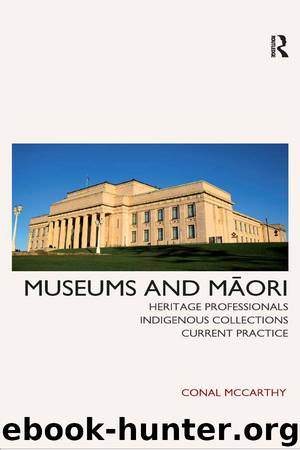Museums and Maori: Heritage Professionals, Indigenous Collections, Current Practice by Conal McCarthy

Author:Conal McCarthy [McCarthy, Conal]
Language: eng
Format: azw3
ISBN: 9781315423876
Publisher: Taylor and Francis
Published: 2016-06-15T16:00:00+00:00
Te Manawa, Palmerston North
While other museums have advisory groups, which sometimes behave like governance structures facilitating relationships with local iwi, this museum has taken the next step by developing a formal relationship with tangata whenua. Te Manawa is a regional cultural centre situated in Palmerston North. Its name means ‘the heart’, and is a reference to the Māori name of the Manawatū region. Te Manawa’s mission is to ‘present, preserve and make accessible collections of art, science and heritage’. These collections of visual art, social history, and science and technology were integrated within this institution in 1999 from the former Manawatu Museum and Science Centre, and Manawatu Art Gallery, which date from the 1970s. Te Manawa is now a charitable trust that is part of the Palmerston North City Council. Its trust deed includes a Treaty clause, and the Treaty is also mentioned in the strategic plan as well as a commitment to ‘living biculturalism’.28
The organisation has a good relationship with the tangata whenua, the Rangitāne people based at nearby Te Rangimārie marae, built up over many years through the personal connections between kaumātua Rangi Fitzgerald and museum director Mina McKenzie. The relationship was formalised through the Te Rangimārie Document adopted in 2001.29 This model was the outcome of a consultation process with tangata whenua led by coordinator Grant Huwyler and funded through Te Papa’s National Services Te Paerangi. The challenge facing the museum was how to engage with other iwi in the wider region while respecting the position of tangata whenua. After a series of hui it was decided that Rangitane would be the central conduit between the museum and other iwi.
As the diagram in Box 23 shows, Rangitāne sit in the centre, brokering relations between the institution and other iwi and hapū, tribes and subtribes, in the region. It was envisaged that the people at Te Rangimārie marae would take the responsibility to ‘identify issues’ that need ‘broader consultation’ to help the board establish policy and assist management and staff to implement policy.30 There are two Māori representatives on the board, nominated by Rangitāne, out of a total of eight.31
Download
This site does not store any files on its server. We only index and link to content provided by other sites. Please contact the content providers to delete copyright contents if any and email us, we'll remove relevant links or contents immediately.
| Anthropology | Archaeology |
| Philosophy | Politics & Government |
| Social Sciences | Sociology |
| Women's Studies |
Cecilia; Or, Memoirs of an Heiress — Volume 1 by Fanny Burney(32064)
Cecilia; Or, Memoirs of an Heiress — Volume 3 by Fanny Burney(31459)
Cecilia; Or, Memoirs of an Heiress — Volume 2 by Fanny Burney(31409)
The Great Music City by Andrea Baker(30784)
We're Going to Need More Wine by Gabrielle Union(18636)
All the Missing Girls by Megan Miranda(14748)
Pimp by Iceberg Slim(13781)
Bombshells: Glamour Girls of a Lifetime by Sullivan Steve(13689)
Fifty Shades Freed by E L James(12918)
Talking to Strangers by Malcolm Gladwell(12881)
Norse Mythology by Gaiman Neil(12836)
For the Love of Europe by Rick Steves(11528)
Crazy Rich Asians by Kevin Kwan(8891)
Mindhunter: Inside the FBI's Elite Serial Crime Unit by John E. Douglas & Mark Olshaker(8707)
The Lost Art of Listening by Michael P. Nichols(7165)
Enlightenment Now: The Case for Reason, Science, Humanism, and Progress by Steven Pinker(6877)
The Four Agreements by Don Miguel Ruiz(6322)
Bad Blood by John Carreyrou(6280)
Weapons of Math Destruction by Cathy O'Neil(5837)
